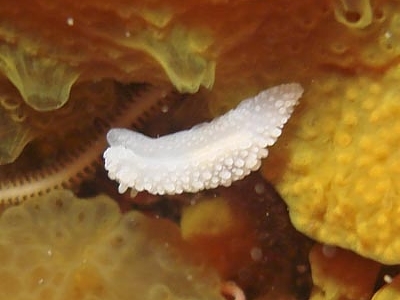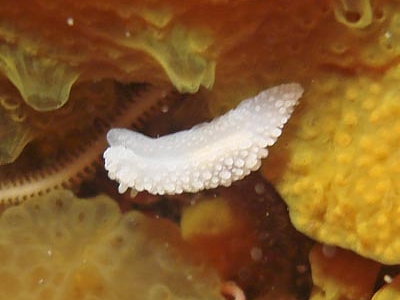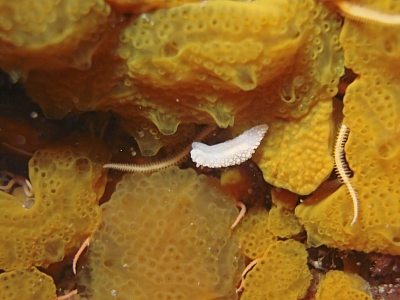
Aegires albus
Thiele, 1912
Order: NUDIBRANCHIA
Suborder: DORIDINA
Superfamily: ANADORIDOIDEA
Family: Aegiretidae
DISTRIBUTION
This species has only been recorded from the Antarctic Peninsula, the Ross
Sea and the Weddell Sea (Wägele 1987).
PHOTO
Locality: Grass Island, Stromness Harbor, South Georgia, Southern Ocean. 16 meters. Length 10 mm. 24 February 2007. Rock wall. Photo:
David Cothran
It is similar in shape to other species of Aegires, but one difference is that it still possesses a distinctive mantle edge which is absent in other species. Odhner (1934) considered the presence of a mantle edge to be enough to place this species in a separate genus Anaegires, but Wägele (1987) reviewed the anatomy of Aegires albus, and Odhner's type species of Anaegires, (A. protectus), and decided that neither the new genus nor the new species were warranted.
It is translucent white with white specks concentrated on the tubercles. The tubercles appear changeable in shape sometimes tall and columnar and at other times lower and rounded. The holotype of A. protectus was 23 mm long preserved, but most records of this species, as A. albus, suggest it is usually about that length alive.
-
Odhner, N.H. (1934) The Nudibranchiata. British Antarctic ("Terra Nova") Expedition, 1910. British Museum Natural History Report, Zoology 7(5): 229-310, Pls.1-3.
-
Thiele, J. (1912) Die Antarktischen Schnecken und Muscheln. Deutsche Sudpolarexpedition 1901-03. Zoology, 5. Berlin. pp. 186-285.
-
Wägele, H. (1987) Redescription and Anatomy of Aegires (Anaegires) albus Thiele, 1912 (Opisthobranchia, Doridacea) and synonymy with A. protectus Odhner, 1934. Polar Biology 7: 267-272.
Rudman, W.B., 2007 (February 25) Aegires albus Thiele, 1912. [In] Sea Slug Forum. Australian Museum, Sydney. Available from http://www.seaslugforum.net/find/aegialbu
Related messages
Aegires albus from Antarctica
February 26, 2007
From: David Cothran

Hi Bill,
Here's one more from the same dive today at Grass Island. I really have no idea about this one - at first I thought a tiny Austrodoris, but that doesn't seem right on a close look.
It was quite small, about 10 mm, and swinging around while attached only by the distal end of it's foot, so this was the best shot I could manage.
Any ideas?
Locality Details: Grass Island, Stromness Harbor, South Georgia, Southern Ocean. 16 meters. Length 10 mm. 24 February 2007. Rock wall. Photo: David Cothran
Thanks again for your help.
Best regards,
David Cothran
david@wandering-eye.com
Cothran, D.B., 2007 (Feb 26) Aegires albus from Antarctica. [Message in] Sea Slug Forum. Australian Museum, Sydney. Available from http://www.seaslugforum.net/find/19539
Dear David,
This is Aegires albus. It is a nice find because as far as I know this is the first published photo of this species alive. It is similar in shape to other species of Aegires but one difference is that it still possesses a distinctive mantle edge which is absent in other species. Odhner (1934) considered the presence of a mantle edge to be enough erect a separate genus Anaegires, but Wägele (1987) reviewed the anatomy Aegires albus, and Odhner's type species of Anaegires, A. protectus, and decided that neither the new genus nor its type species were warranted.
Species of Aegires feed on calcareous sponges, so I suspect its presence amongst, what I assume are colonial ascidians, is a coincidence. If you get the opportunity, it would be interesting to know if Aegires albus also eats calcareous sponges.
This species has only been recorded from the Antarctic Peninsula, the Ross Sea and the Weddell Sea (Wägele 1987).
Best wishes,
Bill Rudman
